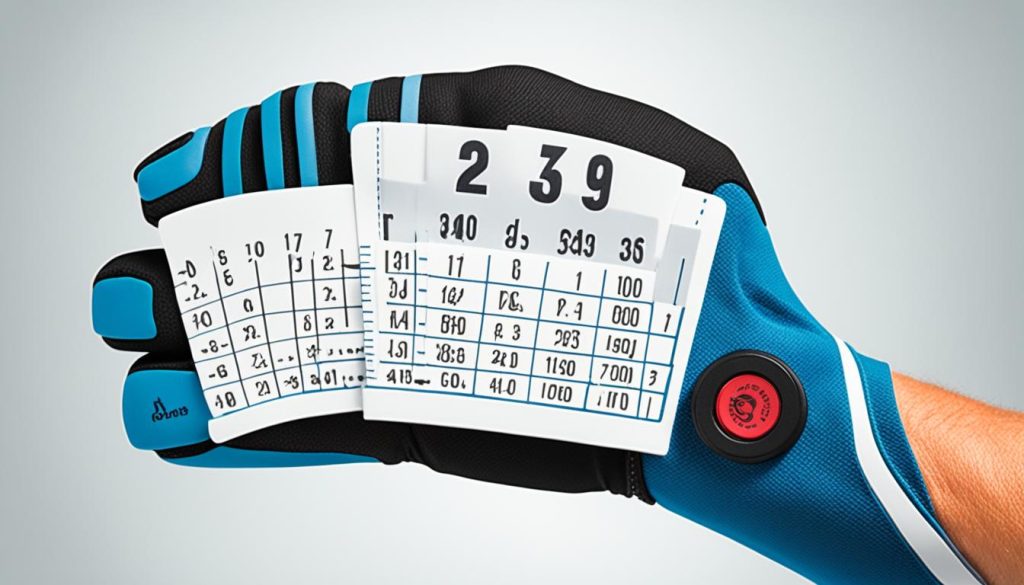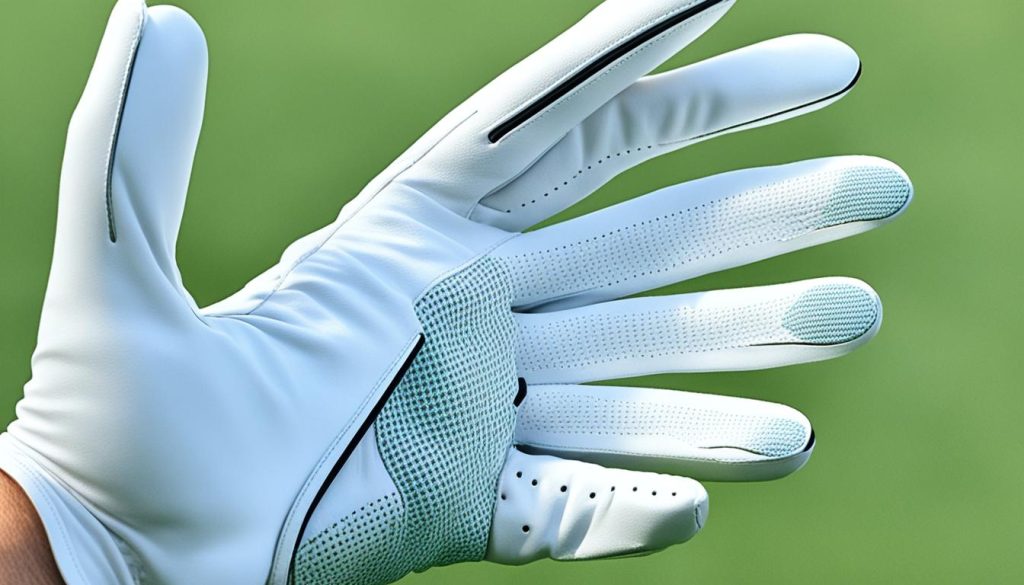Picture this: you’re on the green, ready to take your swing. The sun is shining, the breeze is blowing, and you’re feeling the excitement building. But as you grip the club, you can’t shake the uncomfortable feeling of a poorly fitting golf glove. It’s distracting, it’s frustrating, and it’s affecting your game. We’ve all been there.
Choosing the right size women’s golf glove is crucial for a proper grip and optimal performance on the course. A glove that is too big or too small can affect your swing and overall comfort. Getting the perfect fit can be challenging, especially if you’re between sizes. However, with the right tips and techniques, you can find the right size glove that feels like a second skin.
Key Takeaways:
- Choosing the right size women’s golf glove is crucial for a proper grip and optimal performance.
- A properly fit glove should feel like a second skin, snugly across the palm and fingers.
- Determining your glove size requires measuring the length of your middle finger and the circumference of your hand.
- When between two sizes, it’s generally recommended to try the smaller size first.
- Pay attention to the wear patterns on your golf glove, as they can provide insights into your swing and grip.
The Importance of a Properly Fit Glove
A properly fit golf glove is essential for your game. It is as important as using the right club or golf ball. The glove serves as the closest point of contact between your hand and the club, and any movement or loose material can compromise your swing. A glove should fit like a second skin, snugly across the palm and fingers, with no extra material. It should also provide room for adjustability during play with a tab that covers about 75% of the back of your hand, leaving 1/4″ of Velcro uncovered.
When your glove fits properly, it allows for better hand movement and control over the club. Every swing requires precise hand positioning, and a glove that fits like a second skin ensures that your hand movements are not limited or hindered. It avoids the possibility of slipping or twisting during the swing, providing a secure grip throughout the entire motion. A properly fit glove eliminates the need to adjust your grip mid-swing, allowing for a more consistent and powerful shot.
Another advantage of a well-fitting glove is the enhanced proprioception it offers. A glove that molds to your hand provides a better sense of connection and feedback between your hand and the club. This heightened awareness allows you to make subtle adjustments to your swing and improve overall accuracy. The proper fit also reduces the risk of blisters and calluses, ensuring a more comfortable and enjoyable game.
Benefits of a properly fit golf glove:
- Improved hand movement and control
- Consistent grip throughout the swing
- Enhanced proprioception and feedback
- Reduced risk of blisters and calluses
To achieve a properly fit golf glove, it is important to measure your hand accurately and choose the right size. In the next section, we will explore how to determine your glove size to ensure you find the perfect fit.
How to Determine Your Glove Size
Determining your glove size is a crucial step in finding the right fit. To ensure optimal comfort and performance on the golf course, it’s important to measure two key dimensions: the length of your middle finger and the circumference of your hand measured around the first knuckle (excluding the thumb). By obtaining these measurements, you can find your perfect size and enjoy a glove that feels like a second skin.
To assist you in measuring accurately, FootJoy provides an at-home measuring tool. This downloadable and printable PDF will guide you through the process, ensuring precise measurements of your middle finger length and hand circumference. With these figures in hand, you can refer to a sizing chart provided by FootJoy to identify your ideal glove size.
Remember, taking the time to measure your hand properly is essential for a comfortable and secure fit. It allows you to select a glove that provides the right amount of grip and flexibility, supporting your game on the golf course.
Sizing Tips and Considerations

Choosing the right size golf glove can be tricky, especially when you fall between two sizes. However, with these sizing tips and considerations, you’ll be able to find the perfect fit for optimal performance on the course.
Try the Smaller Size First
When you’re between two sizes, it’s recommended to try the smaller size first. A glove that is slightly snug at first will eventually mold to your hand shape, providing a better fit over time.
Finger Length and Palm Width
Consider the proportions of your Finger Length and Palm Width when selecting a glove size. If your Finger Length is smaller than your Palm Width, you may want to try a Cadet glove in your size. Cadet gloves are designed for golfers with wider palms and shorter fingers, providing a more comfortable fit.
Measure Your Hand
To determine your glove size, use a measuring tape or a printable measuring tool provided by reputable brands like FootJoy. Measure the length of your middle finger and the circumference of your hand around the first knuckle (excluding the thumb). Use these measurements to find your size in the brand’s size chart. Remember to measure your hand at the start of every season to account for any changes.
Consider Men Wearing Women’s Gloves
It’s not uncommon for men to find a better fit in women’s golf gloves, especially if their hand proportions align with the sizing. Men with narrower palms and longer fingers may find that women’s gloves provide a more snug and comfortable fit.
Remember to always try the glove on before purchasing to ensure a proper fit. Your golf glove should fit snugly across the palm and fingers, without any extra material. It should provide a natural feel and flexibility, allowing for proper hand movement during your swing.
By following these sizing tips and considerations, you’ll be able to find the right golf glove size that feels like a second skin, enhancing your grip and overall performance on the course.
What Glove Wear Can Tell You About Your Game

The wear patterns on your golf glove can provide valuable insights into your game. By observing and analyzing specific areas of wear, you can identify areas of improvement and enhance your performance on the course. Let’s take a closer look at different types of glove wear and what they can indicate.
Palm Wear
Excessive wear on the palm of your golf glove may suggest that your hands are slipping during your swing. This can result from improper grip pressure or holding the club with your palms rather than your fingers. To address palm wear, focus on maintaining a firm and consistent grip, emphasizing the pressure on your fingers rather than squeezing with your palms.
Heel Wear
If you notice wear on the heel of your glove, it could be a result of re-gripping at the top of your swing or holding the club too close to the end. This type of wear can affect your clubface control and lead to inconsistent shots. To minimize heel wear, ensure proper hand positioning on the club and avoid excessive movement or adjustments during your swing.
Thumb Wear
Thumb wear on your golf glove might indicate that you’re extending your thumb too far down the shaft. This can negatively impact your grip and lead to loss of control and accuracy. To prevent thumb wear, focus on maintaining a neutral thumb position, pointing it towards the target rather than excessively wrapping it around the club.
Aside from analyzing wear patterns, it’s also important to rotate between multiple gloves. This helps extend their lifespan and allows them to dry out adequately. By rotating gloves, you can prevent excessive wear on a single pair and ensure consistent performance throughout your rounds.
Now that you understand what glove wear can reveal about your game, make it a habit to regularly inspect your gloves for signs of wear and adjust your technique and grip as needed. Remember, a well-maintained glove can enhance your comfort, control, and overall performance on the golf course.
| Glove Wear | Indication | Tips for Improvement |
|---|---|---|
| Palm Wear | Hands slipping during swing | – Maintain firm grip with pressure on fingers – Focus on proper grip technique |
| Heel Wear | Re-gripping at top of swing or holding club too close to the end |
– Ensure proper hand positioning – Minimize unnecessary swing adjustments |
| Thumb Wear | Extending thumb too far down the shaft | – Maintain neutral thumb position – Avoid excessive thumb wrapping |
Regular vs. Cadet Sizing
When it comes to choosing the right golf glove, getting the perfect fit is crucial for your performance on the course. That’s why FootJoy offers two different cuts for their gloves: Regular and Cadet. Understanding the differences between the two can help you find the ideal fit for your hand.
Regular sizing is designed for golfers with standard palm and finger proportions. It provides a comfortable and snug fit, hugging your hand like a second skin. The glove should have no extra material, ensuring optimal grip and control over your club.
On the other hand, Cadet sizing is suitable for those with wider palms and shorter fingers. If you find that a Regular glove has excess material at the tops of your fingers, it may be worth considering a Cadet glove. Cadet gloves are designed with these proportions in mind, offering a better fit for individuals with shorter fingers.
Another factor to consider is finger swelling. If your fingers tend to swell during a round of golf, a Cadet glove might provide a more comfortable fit. The wider palm and shorter fingers of a Cadet glove can accommodate finger swelling better than Regular gloves.
Here’s a summary of the key differences between Regular and Cadet sizing:
| Regular Sizing | Cadet Sizing |
|---|---|
| Designed for standard palm and finger proportions | Suitable for wider palms and shorter fingers |
| No extra material | Better fit for individuals with excess material at the tops of their fingers |
| May not accommodate finger swelling | Provides a more comfortable fit for finger swelling |
When choosing between Regular and Cadet sizing, it’s essential to try on the gloves and assess the fit personally. Remember, the right glove should feel like a second skin, snugly fitting across your palm and fingers, with no excess material. Consider your palm and finger proportions, as well as any potential finger swelling, to find the glove that offers the best fit and performance for your game.
Specialty Gloves for Different Conditions
Golfing in adverse conditions requires specialized gloves to ensure a comfortable and optimal playing experience. Whether you’re facing wet weather, cold temperatures, or humid and sweaty conditions, there are gloves available to meet your specific needs.
For wet and cold conditions: When dealing with wet weather, waterproof gloves are essential. These gloves are designed to keep your hands dry, providing an enhanced grip even in wet conditions. Cold weather gloves, on the other hand, offer insulation to keep your hands warm while still maintaining flexibility, allowing you to swing with ease.
For humid and sweaty conditions: In hot and humid weather, it’s important to choose gloves that promote airflow and keep your hands dry. Mesh gloves are a popular choice as they allow for better ventilation, ensuring that your hands stay comfortable and sweat-free throughout your game.
Proper care and maintenance of your gloves play a crucial role in their longevity. To keep your gloves in top condition, consider the following tips:
– Rotate your gloves: By alternating between multiple gloves, you can reduce the stress on one glove and extend their overall lifespan.
– Lay them flat to dry: After each round, make sure to lay your gloves flat to dry. Avoid hanging them up or exposing them to direct heat, as this can cause them to warp or lose their shape.
– Gentle cleaning: If your gloves become dirty or stained, gently wipe them clean with a damp cloth. Avoid using harsh chemicals or abrasive materials that could damage the glove’s material.

